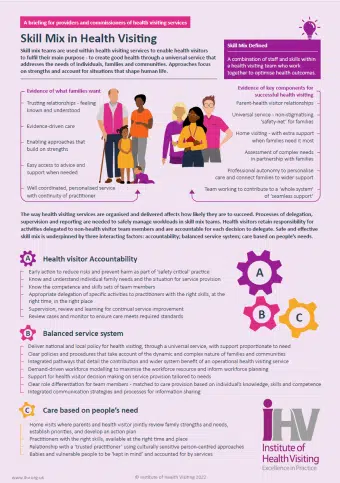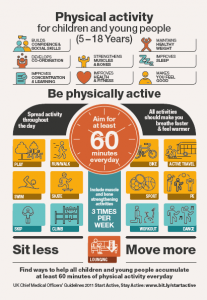The new iHV infographic on skill mix in health visiting has been prepared for practitioners, service managers and commissioners involved in skill mix decision making.
This co-produced resource is the result of work with a UK-wide reference group providing perspectives as parents, practitioners, educationalists, service leads and professionals working with families and communities. Given the limited evidence for how skill mix in health visiting works, we have identified transferable messages from the broader skill mix literature and drawn on bodies of research evidence for what families want from services and what contributes to successful health visiting practice.
The collective messages from these bodies of evidence, have been distilled as the ABC of skill mix in health visiting to identify issues concerning: Accountability of health visitors; Balance in the service system; and Care based on people’s needs.

Next phase
The next phase of the skill mix work will include case study examples to illustrate the accountability of health visitors and pathways of decision making when delegating. To contribute to this phase please contact Karen Whittaker: [email protected] who would welcome discussing potential case studies.
Stakeholder comments on the infographic:
Elizabeth Duff, Senior Policy Adviser, National Childbirth Trust (NCT)
“All the right themes have been highlighted in this piece of work. Relationship-based care and support of the family’s strengths take centre stage, as they should. Accountability is absolutely key, especially when some tasks are delegated. Overall, this helps everyone concerned be clear what families can expect and how their needs will be met.”
Sally Ashton May, Director for Midwifery Policy and Practice, The Royal College of Midwives
“The infographic provides a clear and concise yet comprehensive overview of skill mix in health visiting. The approach supported by a robust evidence base provides a useful resource for service users and healthcare professionals and illustrates the added value skill mix brings to the Health Visiting team. ”
Sharon White OBE, CEO, SAPHNA
“We welcome this publication on the appropriate use of skill mix in health visiting services which will help towards ensuring the delivery of safe, quality and effective services through the alignment of skills and competencies across the workforce.”
Sunita Sharma, Consultant Obstetrician and Gynaecologist, Chelsea and Westminster Hospital NHS Foundation Trust
“This guidance from iHV is much-needed and very timely as different teams and services strive to provide personalised family-centred support for all parents and work collaboratively within the current constraints.”
Melanie Farman, Development Manager – Enhanced Healthy Child Pathway & Specialist Services, Better Start
“Distilling down key messages about a complex provision such as skill mix in health visiting can be challenging. This infographic recognises these challenges and tensions, providing a clear framework of the important factors for successful implementation. Of note is the emphasis on sill mix supporting care that is individualised, person-centred and based on evidence.”
Clinical Practice Improvement Lead for Children’s Services, London
“A very comprehensive infographic capturing all of the elements required to deliver a safe and sustainable skill mix model. It clearly identifies the overarching service responsibility and accountability dimensions. Having implemented a skill mix model for a number of years this infographic can be used to guide and develop a skill mix service.”






